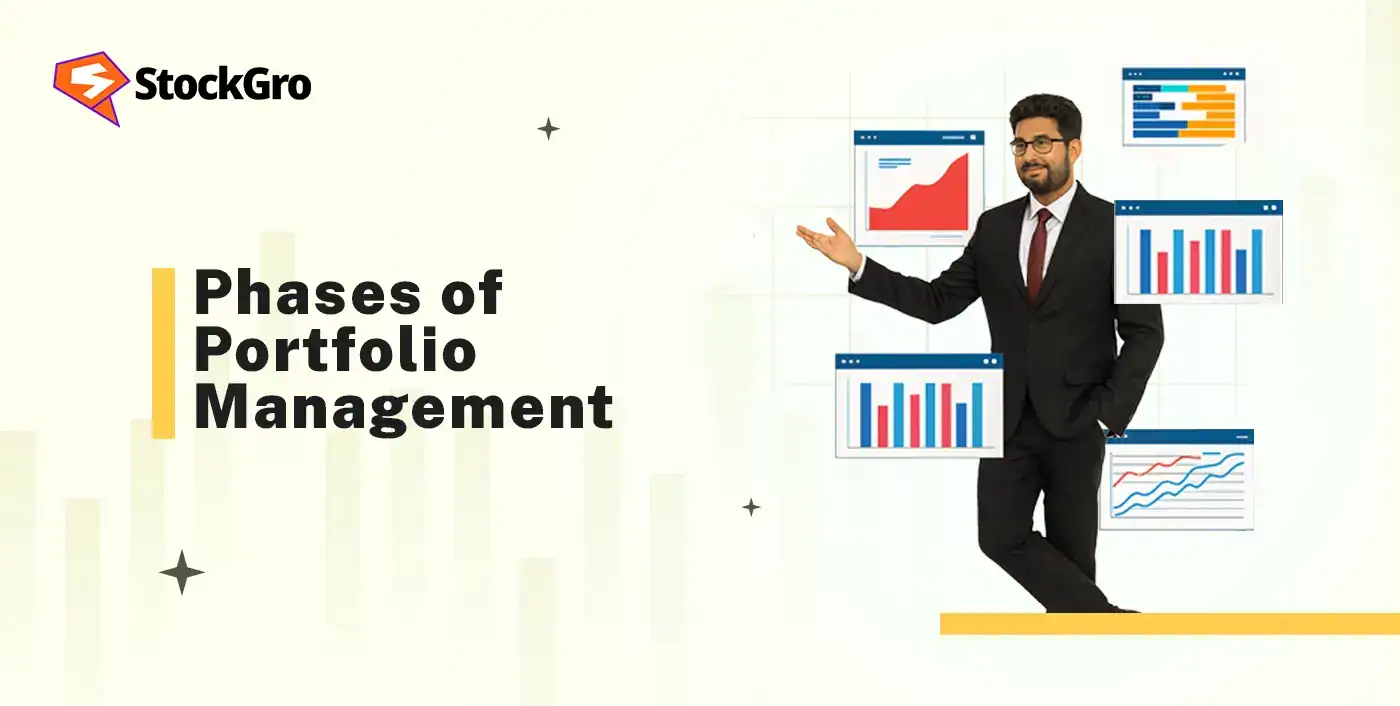
In recent years, portfolio management in India has grown rapidly as more investors are moving beyond traditional options to explore new and diversified financial instruments.
As of September 2025, the total AUM(Assets Under Management) managed by portfolio managers reached ₹40.33 lakh crore. This huge number indicates that investors are not interested in just individual stock picks anymore; they are looking for a structured approach to managing their investments . That’s exactly what portfolio management is: a systematic process that takes you from selection of securities to performance evaluation, helping you achieve consistent long-term growth.
Let’s explore the five key phases of portfolio management that every investor should understand.
Phases of Portfolio Management
Portfolio management is a five-phase process that guides investors in their investment journey. Each phase has a different purpose in your portfolio management journey. The phases ensure that the portfolio has a stable structure aligned with your financial goals, risk appetite, and changing market conditions. Only then will it be able to deliver long-term sustainable returns for you.
By following a phase-wise approach, you can bring consistency and discipline to your portfolio, which improves its performance in the long run.
Phase 1: Security Analysis
Security analysis is the foundation of portfolio management. It involves deeply analysing various asset classes — such as equities, bonds, mutual funds, and ETFs. This is done in order to evaluate their potential risks and expected returns. Security analysis is done by studying company financial statements, tracking sectoral trends, and following macroeconomic indicators .
By conducting a detailed security analysis, you can ensure that your portfolio is built on fundamentally strong assets. This not only enhances the long-term growth potential of your portfolio but also reduces the risk of market downturns.
Phase 2: Portfolio Analysis
After identifying the right securities, the next step is portfolio analysis. This phase focuses on how the selected securities work together within your portfolio rather than on their individual performance. Portfolio analysis examines the overall impact these securities create collectively . An investor must evaluate whether the combination of securities provides:
- A balance between maximised returns and limited risk exposure
- Liquidity to withstand emergencies or capitalise on opportunities
- Stability during different market cycles and economic conditions
A well-analysed portfolio is the key to achieving your long-term financial objectives.
Phase 3: Portfolio Selection
After completing security and portfolio analysis, the next step is portfolio selection. This is where you decide which particular assets will make up your portfolio and in what proportion with each other. At this stage, your portfolio transitions from the planning stage to implementation.
The key tasks in portfolio selection are given below:
- Finalising the securities to be included from the shortlisted options.
- Assigning weights to the securities based on asset allocation.
- Buying the particular securities so that the portfolio can come into existence.
This phase changes your investment plan into action.
Phase 4: Portfolio Revision
Portfolio revision means making periodic changes in your portfolio to react to the changing market dynamics. Over time, the market fluctuations can cause some investments to over or underperform your expectations. Portfolio revision makes sure that your portfolio still has the right structure to meet your financial goals.
Regular portfolio revision should be carried out to keep your portfolio stable, minimise risk exposure, and keep it on track toward your investment journey.
Phase 5: Portfolio Evaluation
Evaluation is the final and perhaps most crucial phase in the portfolio management process. After all the steps, the evaluation puts you in the back seat to assess the performance of your portfolio. It involves comparing the portfolio’s performance against benchmarks to understand its returns and associated risks.
During evaluation, you should focus on:
- Has the portfolio managed to meet your expectations?
- How much return has your portfolio generated compared to different benchmarks?
- What level of risk was the portfolio exposed to for achieving the returns?
- Is the portfolio strategy performing according to the desired goals, or does it need any corrective actions?
This phase tells you whether the overall portfolio management process is working properly and delivering you the desired results.
Alternative Framework: Objectives to Evaluation
There is an alternative framework in portfolio management that directly connects your objectives to the evaluation phase in portfolio management . It ensures that every action is in the direction of meeting your objectives.
In this framework, the following things are considered:
Objectives: which are quantifiable in nature- expected returns on investment, exposure to risk, and extent of diversification
Evaluation Criteria: metrics such as Beta and Jensen’s Alpha to assess the portfolio’s performance
Analytical Tools such as CAPM and risk-return analysis to measure the objectives with their evaluated performance.
This framework provides a more direct approach to the portfolio management process.
The Planning-Execution-Feedback Loop
The Planning-Execution-Feedback Loop is a continuous activity that runs in circles. In this loop, plans are made, their execution is done, and the results are used to provide feedback for the next round of planning. In the context of portfolio management, this loop will look like:
Planning: In this phase, a portfolio strategy based on the financial goals, risk tolerance, and time horizon of the investor is made.
Execution: The plan is put into action by constructing the portfolio, and the portfolio comes into existence.
Feedback: The portfolio’s performance is analysed, and the results are used as feedback for future planning.
This loop ensures that the portfolio remains efficient and adaptable to any market changes.
Conclusion
Portfolio management is a multi-step activity that is continuous in nature. The different phases are there to guide you in your investment journey. When you follow the structured approach of portfolio management, your actions gain meaning and your portfolio gets the right structure to work for your desired financial goals.
At the end, it is crucial to understand the phases of portfolio management as they are the defining factor behind sustainable financial growth.
FAQs
The five main phases are security analysis, portfolio construction, portfolio selection, portfolio revision, and portfolio evaluation.
Markets and financial goals both change over time. Portfolio revision helps the portfolio to adapt to any market changes and aligns it with the changing objectives.
Evaluation is done after investing to see how the portfolio is performing, and analysis is done before investing to select the particular assets that will make up the portfolio.
Yes, you can skip phases as a DIY investor. But skipping the phases may weaken the portfolio structure and hamper its performance.
There is no fixed guideline, but evaluation should be done on a consistent basis. Quarterly and annually evaluating works for most of the investors.
An individual investor can use a simple framework, like objectives to evaluation, as it is easier to understand and implement. For institutional investors, following all the phases along with using a planning-execution-feedback framework is more suitable as their decisions require more complexity and consistent action.

